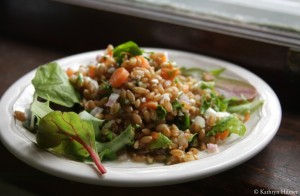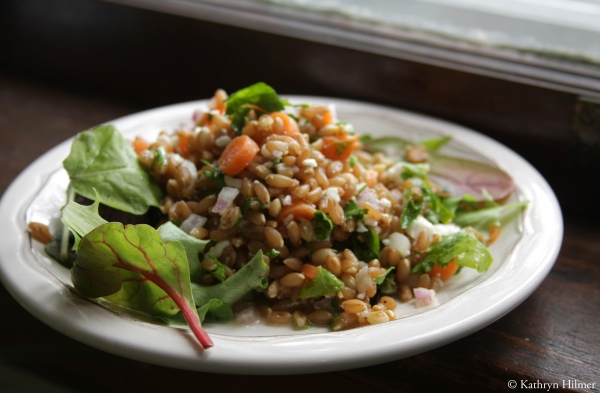If you read GoodFood World‘s last article on the subject (Grass-Fed vs. Feedlot beef), you already know that the difference between organic and conventional meat is bigger than the cost at the checkout. Meat and poultry that is conventionally produced to reach the market quickly and in large quantities comes to us at a cheap cost, but it’s a high price to pay for the environment and our health (not to mention animal cruelty issues).
Fortunately, there are steps we can take to make it easier; not only for the earth, but for our wallets, our conscience, and our bodies. Here are some ideas, in no particular order of importance. Depending on your situation, one might take priority over another, but I find that they work best in combination.
-

Tofu Marinade Eat less meat (best for: the environment, your health, the animals, your wallet)
.
There are lots of reasons to eat less meat. For one, it’s expensive! When we decided to switch to a mostly organic diet, we found we couldn’t afford to eat as much meat. But as a result we found that we really didn’t need to. According to the Harvard School of Public Health, having meat as the center of every meal is neither necessary nor healthy.
.
You’re likely to eat a more balanced diet when you break free of the meat-and-potatoes mindset. We have found that we enjoy vegetarian meals just as much, and having meat less makes us appreciate it more. We incorporate it as a sort of complementary ingredient into recipes for stir-fries, tacos and curry.
.
If your health and your budget aren’t a factor, there’s still the environmental strain caused by large-scale meat production. You’ve probably heard of “Meatless Mondays” –people everywhere are going without meat one day a week for a variety of reasons. Check out this website for more info. . -

Tabbouleh, Instead Eat organic meat or “all natural” (best for: the environment, your health, the animals)
.
This bit of advice is best taken in conjunction with the one above, due to the fact that organic meat is much more expensive than conventional. In a survey of my local grocery stores, I found that organic chicken was at least twice the cost of conventional (per pound) and as much as five times the cost for certain cuts. But if you eat less of it in general, you’ll be able to afford the higher-quality stuff. If you still can’t afford organic (I’ll be honest, I usually can’t) then all-natural is the next best thing.
.
Meat with the “all-natural” label contains no artificial colors, additives, or preservatives. It means minimally processed… it doesn’t mean that the animals were humanely treated or fed only organic feed. The label is not well-regulated, so use your own discretion. I find that the next-best to organic is all natural from a local producer. Which brings me to my next recommendation… . -

Soba Veggies Eat local meat (best for: the environment, likely your health, the animals)
.
Eating local means that less resources were put into bringing the meat to you. It doesn’t guarantee that the animals lived happily, or that the meat was minimally processed. It means you’re supporting your community, and usually that’s small farmers.
.
If you buy from small farmers, you’re closer to the source of your food, and that makes it easier to know what you’re getting for your money. If you do a little digging (farmers markets are a great place to ask questions), you’ll be able to make the right choices.. - Butcher your own meat (best for: your wallet, the environment)
.
It doesn’t mean you have to wear a dirty white apron and hack at carcasses with a meat cleaver! When you pay for boneless, skinless, fat-trimmed meats, you’re paying extra to have someone eliminate those parts of the animal. Cooking with meat that has bones and fat is going to be cheaper and more flavorful… it only takes a little more effort to prepare on your part. You’ll also be saving resources that would otherwise go into extra processing.
.
You can roast whole cuts of meat (like a whole chicken, or thighs and drumsticks) and make gravy from the drippings, or boil the scraps to make an excellent broth. Just be sure to cool the liquid and skim off the fat that rises to the top.

Last week, we bought a local, all-natural, whole chicken, and from it we were able to have more than four meals for two. Here’s the recipe: delicious Roasted Chicken with Herb Butter. More recipes to come soon, including surprisingly yummy marinated tofu, on my new blogsite, Natural Born Baker.
Sources:
http://helpguide.org/life/organic_foods_pesticides_gmo.htm
http://www.hsph.harvard.edu/nutritionsource/what-should-you-eat/protein/
http://www.meatlessmonday.com/why-meatless/


Thank you Marilyn. In an effort to be brief I had grouped grass-fed under organic, but it’s important to know that they’re not the same; grass-fed beef is not necessarily organic and vice versa. Sadly, not all producers who sell under the organic label actually practice organic methods on the farm – such as allowing the animals to graze in rotation and letting their diet reflect what the animals would naturally eat.
I think it’s also important to note that the term grassfed, as it applies to ruminant animals who are raised one hundred percent on grass, only refers to cattle, bison, goats, and sheep. For pigs and poultry, we can look for the free-range and organic labels, but as you pointed out the best way to know for sure what you’re getting is to be in direct contact with the producer.
Dear Kate,
Thanks for writing such informative articles about meat. I wanted to clarify some terminology that your readers may find confusing.
Organic is not the same as grassfed and doesn’t mean the animals spend their whole lives eating grass in a pasture; in fact, much of the organic meat on the market actually comes from feedlots. The animals are finished on organic grain, but they’re kept in confinement for the final months of their lives. Conversely, many grassfed producers use organic practices but are not certified organic.
“Natural” refers to what happens to meat after the animal is processed — “naturally raised” is the term recognized by the USDA that says the animals are not given antibiotics, hormones, or animal by-products during their lives. Again, they may be fed grain and spend the last months of their lives in feedlots.
The best meat is grassfed. The USDA has standards that govern usage of the term, but the best way to know that an animal has been raised one hundred percent on grass for its entire life with no antibiotics, hormones, or animal by-products, and without confinement in a feedlot, is to look for American Grassfed Association certification. AGA is the only third-party certifier of grassfed ruminant animals in the country and producers must meet stringent criteria to be able to use the AGA logo.
The best way for consumers to know what they’re eating is to ask the person who produces the food, whether that’s meat or produce.
For more information on meat labels, please check out this article from Maria Rodale’ blog. http://www.mariasfarmcountrykitchen.com/how-to-buy-grass-fed-meats/